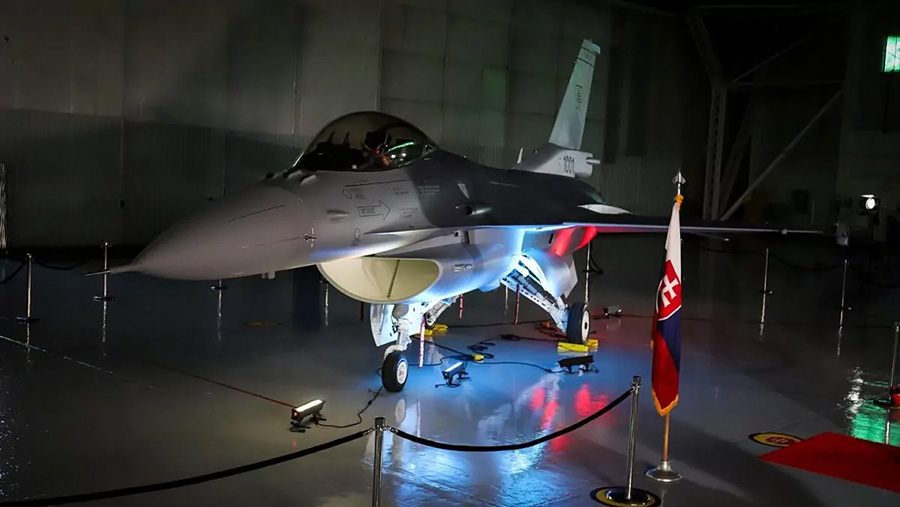Slovakia's first F-16 fighter jet landed at an air base in Arizona, but there is no adequate infrastructure for these planes in Slovakia
The Headquarters of the Air Force of the Armed Forces of the Slovak Republic (AF SR) recently announced that the manufacturer Lockheed Martin has released the first Slovak-made F-16D Block 70 fighter aircraft for the training of pilots and technical personnel of the Slovak Air Force. This is a major milestone in the Slovak Army's largest modernisation project, as until now Slovak pilots and aircraft mechanics have been trained on various other F-16 variants from the US Air Force's arsenal. A slightly less positive fact is that Slovakia has not yet built the appropriate infrastructure for the operation of these aircraft.

The recent release of the first, two-seat F-16D Block 70 fighter aircraft follows the official handover of two machines to the Slovak Armed Forces in March. The handover ceremony of the first two F-16s at Lockheed Martin's production facilities was attended by Slovak Defence Minister Robert Kaliňák. The head of the Ministry of Defence recalled that modern F-16 fighter jets are a guarantee of the highest quality not only from the technological point of view, but also from the point of view of the safety of servicemen and women. At the same time, the Ministry of Defence said in a press release that the first F-16s will be delivered to Slovakia during the second quarter of this year. Specifically, three aircraft are to be delivered.
The contract for the purchase of 14 F-16C/D Block 70 fighter jets, worth over €1.9 billion, was signed by former Defence Minister Peter Gajdos in 2018. In addition to the purchase of the 14 F-16s themselves, the contract also includes ammunition, training and two-year operational support for all 14 aircraft. The U.S.-origin aircraft were ordered to replace the MiG-29AS and MiG-29UBS. According to an analysis by the Slovak Supreme Audit Office (SAO), in 2018, two-thirds of the 12 MiG-29s were in non-operational condition and their weapons systems had become morally and technically obsolete. The SAO also criticized the process by which the F-16 fighters were acquired in its 2021 analysis of the purchase. Criticism was levelled at the then outdated strategic defence documents, the lack of approval of the purchase by the National Council of the Slovak Republic, the lack of justification of the purchase by the Ministry of Defence, and even the prioritisation of the investment over the commitment to build a heavy mechanised brigade. However, in addition to these points, another serious problem has emerged, and that is the lack of infrastructure for the operation of the F-16.
As Daniel Zmeko, Chief of the General Staff of the Slovak Armed Forces, told Slovak Television, no military airfield in Slovakia has been modernised for 30 years. According to the original plans, the Sliač airport, where MiG-29 fighter jets were stationed, was to be reconstructed from 2019. The cost was then set at EUR 55.38 million by the Slovak MoD. The recently published SAO audit report states that the feasibility study for the reconstruction of Sliač airport was published in 2023. Here, the cost estimate for the reconstruction of Sliač airport is EUR 126 million. It should be noted here that in 2020, the then leadership of the Ministry of Defence decided to implement the reconstruction of the military airport through the NSPA. Some specialists and experts from the military and defence community claim that the alliance agency NSPA is not the most suitable for this type of project and the SAO audit confirmed that the involvement of NSPA in the modernisation of Sliač airport did not actually contribute to a faster implementation of the process.
The current leadership of the Ministry of Defence, headed by Minister Robert Kaliňák, has decided that the F-16 fighter jets will be temporarily stationed at the airport in Kuchyně, where temporary facilities in the form of mobile hangars will be created for the new jets. According to Defence Minister Robert Kaliňák, the ongoing reconstruction of the Sliač base will take two to three years to complete. However, according to the SAO audit report, only 8 F-16s can be accommodated at Kuchyně airport. The remaining six fighters will be used to train Slovak pilots in the USA. At the same time, the Ministry of Defence is considering the possible acquisition of four more F-16s.
Despite the problems Slovakia has to face in connection with the purchase of F-16 fighter aircraft, it is positive that the project is on track and the Slovak Air Force will soon see its first modern fighter aircraft directly in Slovakia. According to the Slovak Ministry of Defence, the Slovak supersonic air force is entering a new era thanks to the delivery of F-16s. One can certainly agree with this opinion, as the MiG-29s Slovakia delivered to Ukraine last year did not have adequate technology for the modern battlefield. It is now important, also in view of the current security situation, that the current leadership of the Ministry of Defence should see to it that repairs to the permanent facilities for the fighter aircraft are carried out as quickly as possible, so that they can serve not only the needs of the Slovak Armed Forces but also those of the Alliance partners.




















